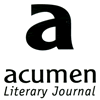Responses
Dear Acumen,
I would like to add a complementary view to those expressed in James Aitchison’s interesting and thoughtful essay, A Natural History of the Muse, in Acumen 49. James interprets Graves’ sentence: “Truth has been represented by poets as a naked woman; a woman divested of all garments or ornament that will commit her to any particular time and space” as suggesting the physical quality of the poet’s union with the Muse, when the goddess, by emerging into the light of the poet’s consciousness, assumes a mortal form. I believe that Graves’ sentence means the exact opposite – when Graves says that the Muse is divested of all “that will commit her to any particular time and space”, he means that she is divested of all that would commit her to being mortal – which is, after all, being incarnate in time and space, in the material world. The fact that she appears to the poet in human form is due to a limitation of the poet’s human consciousness, in that that we humans cannot, with our modern consciousness at least, conceive or picture immaterial (spiritual) realities except through the medium of the soul, and moreover, through a soul that lives in a mortal body, and is to a great extent full of the pictures of a material world. Jung’s percep-tion of the nature of the unconscious, a feminine unconscious for a man and a masculine for a woman, is important here. Rudolf Steiner (who in terms of under-standing the human being, seems to me to stand head and shoulders above anyone else of the twentieth century) said something very similar (although I simplify for the sake of brevity) – that the soul of the man is female and the soul of the woman is male. What he added to this was that there is more than the soul; that an ancient perception of a threefold nature of man as body, soul, and spirit, is quite correct, and that this threefold nature is fundamental to all understanding of the human being. Understanding the distinction between soul and spirit is not at first easy (partly because it disappeared from Western consciousness for over a thousand years), but I am certain that Shakespeare did so, and without space to explain it here, I can only refer to my essay “Othello and the human spirit” (Temenos Academy Review 6), which I hope is a good introduction to the subject. But the point I wish to make, ignoring for the moment the materialist concepts of neuroscience, is that the Muse is a spiritual being, and can only appear to human consciousness within the conscious human soul. If that soul, as Steiner asserts, and Jung in his own way reinforces, is inherently incomplete, a one-gendered reality, then we can only expect that what exists as spirit, when it is understood as a picture in the soul, will appear in a picture that is set in the context of gender. What is spiritual is above gender (“they neither marry nor are given in marriage”; Matthew 22:30), but because of the way in which human beings must perceive it, a spiritual reality can only be seen as a picture on a gendered canvas. We do not therefore need to understand the sexual, which is a characteristic of the body and the soul, as a characteristic of the spiritual in itself, we only need to see it as a factor, and limitation, of our perception.
As a further point, I want to present a challenge to James’ last paragraph. There are many of us for whom the myths of the Muse and the anima have not only not died, but who see them as only ‘mythical’ in the sense of a metaphorical picture of a spiritual truth that cannot be easily expressed in the language of the modern human mind, whose words and concepts are largely dominated by the material world. Those who know from their own experience that there is a real world beyond the immediately perceived material and sensory reality, know also how little we know of that world. However, the new shoots of a naturally developing perception of that world are already evident, and despite all the attendant dangers, their existence suggests that the inspiration of poets, far from being constrained by the dangerous illusions of materialism and the concepts of neuroscience, will have all the more possibilities for the future.
Colin Moss
North Somerset
Page(s) 122-123
magazine list
- Features

- zines

- 10th Muse
- 14
- Acumen
- Agenda
- Ambit
- Angel Exhaust
- ARTEMISpoetry

- Atlas
- Blithe Spirit
- Borderlines
- Brando's hat
- Brittle Star

- Candelabrum
- Cannon's Mouth, The
- Chroma
- Coffee House, The
- Dream Catcher
- Equinox
- Erbacce
- Fabric
- Fire
- Floating Bear, The
- French Literary Review, The
- Frogmore Papers, The
- Global Tapestry
- Grosseteste Review
- Homeless Diamonds
- Interpreter's House, The
- Iota
- Journal, The
- Lamport Court
- London Magazine, The
- Magma
- Matchbox
- Matter
- Modern Poetry in Translation
- Monkey Kettle
- Moodswing
- Neon Highway
- New Welsh Review
- North, The
- Oasis
- Obsessed with pipework
- Orbis
- Oxford Poetry
- Painted, spoken

- Paper, The
- Pen Pusher Magazine

- Poetry Cornwall
- Poetry London
- Poetry London (1951)
- Poetry Nation
- Poetry Review, The
- Poetry Salzburg Review
- Poetry Scotland
- Poetry Wales
- Private Tutor
- Purple Patch
- Quarto
- Rain Dog
- Reach Poetry
- Review, The
- Rialto, The
- Second Aeon
- Seventh Quarry, The
- Shearsman
- Smiths Knoll
- Smoke
- South
- Staple
- Strange Faeces
- Tabla Book of New Verse, The
- Thumbscrew
- Tolling Elves
- Ugly Tree, The
- Weyfarers
- Wolf, The

- Yellow Crane, The
